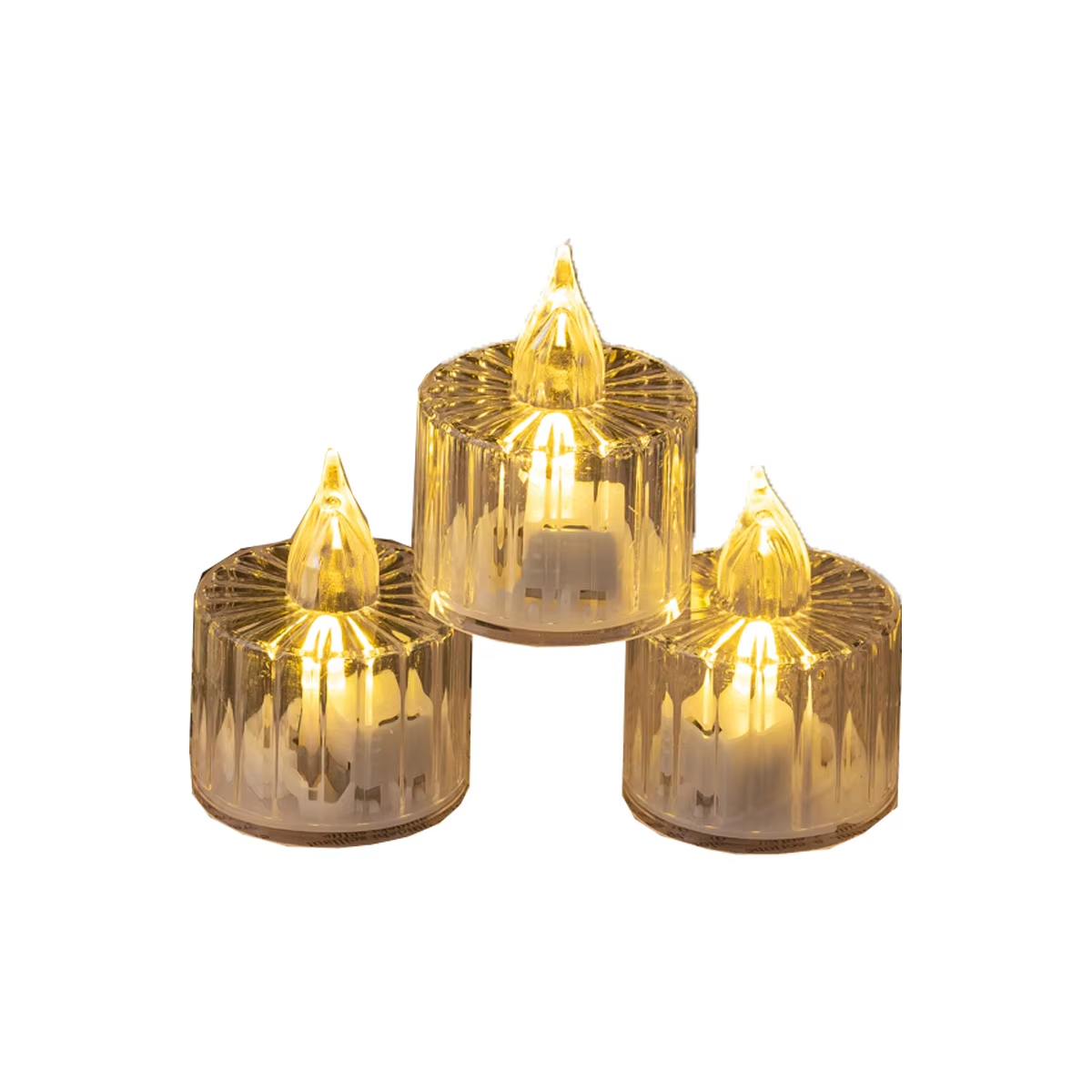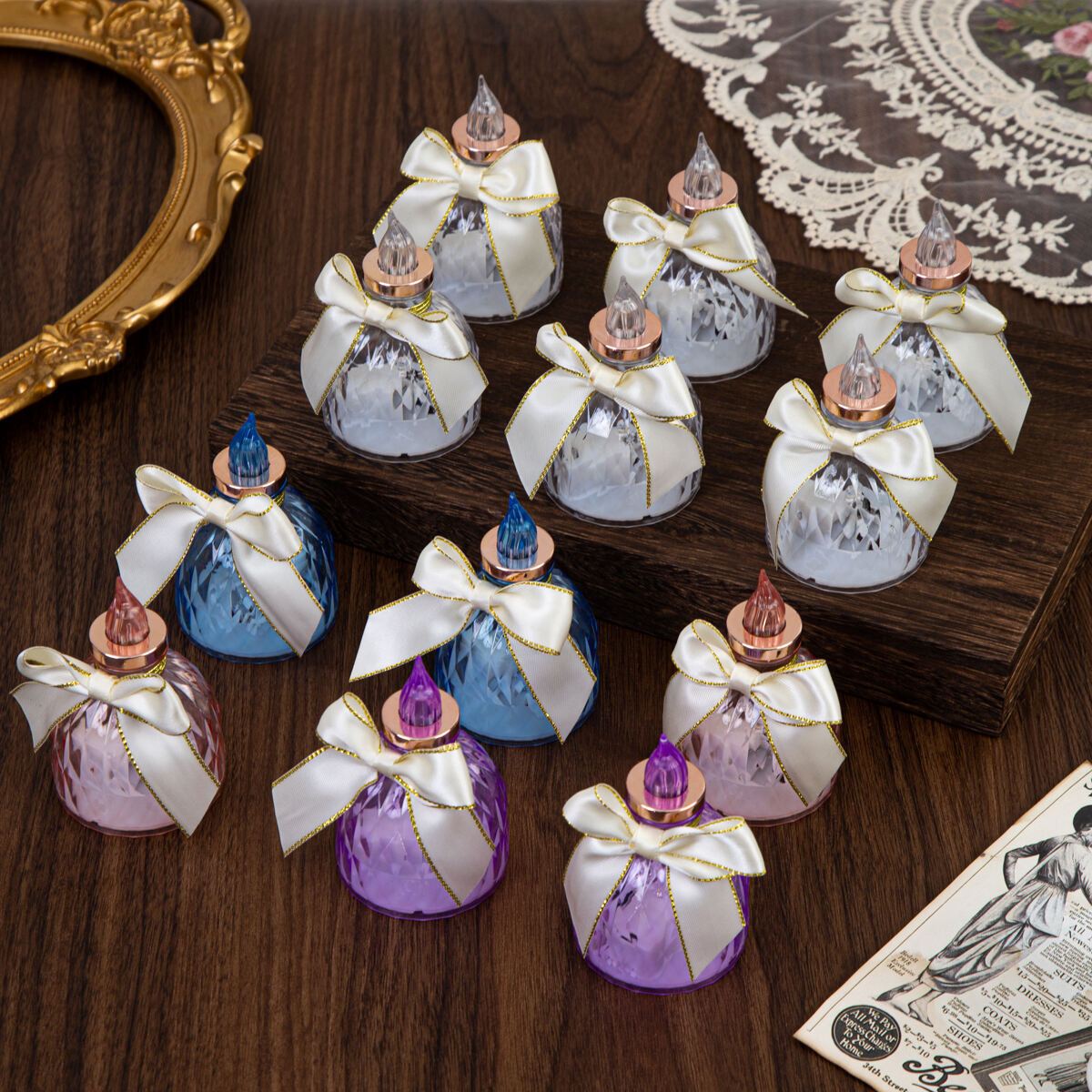Safety considerations in fire-sensitive environments have become increasingly important for businesses and homeowners alike. When it comes to creating ambient lighting in areas where traditional candles pose risks, plastic LED tea lights offer an innovative solution that combines aesthetic appeal with enhanced safety features. These battery-powered alternatives eliminate the open flame hazard while maintaining the warm, flickering glow that makes traditional candles so desirable for decorative and atmospheric purposes.
The growing demand for flame-free lighting options stems from strict fire safety regulations in commercial spaces, healthcare facilities, educational institutions, and residential areas with vulnerable populations. Understanding the capabilities and limitations of LED tea light technology helps facility managers, event planners, and safety coordinators make informed decisions about lighting solutions that meet both regulatory requirements and aesthetic goals.
Understanding Fire Safety Classifications
Regulatory Standards for Fire-Sensitive Environments
Fire-sensitive areas are typically classified based on occupancy type, building materials, and the presence of flammable substances or vulnerable populations. These classifications determine which lighting options are permissible under local fire codes and safety regulations. Hospitals, nursing homes, schools, and childcare facilities often fall under the most restrictive categories due to the potential for delayed evacuation or the presence of individuals who may not respond quickly to emergency situations.
Most fire safety codes specifically prohibit open flames in certain environments, making traditional candles unsuitable for many commercial and institutional applications. The National Fire Protection Association and similar organizations worldwide have established guidelines that favor electrical lighting systems over combustion-based alternatives. These regulations recognize that even small flames can ignite nearby materials or create panic during emergency situations.
Risk Assessment Factors
When evaluating lighting options for fire-sensitive areas, several factors must be considered beyond the immediate flame risk. The presence of oxygen-enriched environments, such as those found in medical facilities, can accelerate combustion and make even small ignition sources extremely dangerous. Similarly, areas with stored chemicals, paper products, or textile materials require additional precautions to prevent accidental fires.
The mobility and cognitive abilities of occupants also influence safety requirements. Facilities serving elderly residents, young children, or individuals with disabilities must account for potentially slower evacuation times and reduced ability to respond to fire emergencies. In these environments, eliminating all possible ignition sources becomes a critical component of comprehensive fire prevention strategies.
LED Technology Safety Advantages
Elimination of Ignition Sources
The primary safety advantage of plastic LED tea lights lies in their complete elimination of open flames and high-temperature components. Unlike traditional candles that can reach temperatures exceeding 1000 degrees Fahrenheit at the flame tip, LED units typically operate at temperatures only slightly above ambient room temperature. This fundamental difference removes the primary ignition risk associated with decorative lighting in sensitive environments.
The solid-state nature of LED technology means there are no hot filaments, glowing elements, or combustible wicks that could potentially ignite nearby materials. Even in the unlikely event of electrical malfunction, modern LED tea lights incorporate safety circuits that prevent overheating and automatically shut down the unit if abnormal conditions are detected. This built-in protection provides multiple layers of safety beyond the inherent low-temperature operation.
Battery Safety Considerations
Modern plastic LED tea lights utilize advanced battery technologies that have been extensively tested for safety in consumer applications. Lithium and alkaline batteries used in these devices are designed to operate safely within normal temperature ranges and include protective circuits to prevent overcharging, over-discharging, and thermal runaway conditions. The low power requirements of LED technology further reduce stress on battery systems.
Quality manufacturers implement additional safety features such as battery compartment designs that prevent short circuits and thermal protection that automatically disconnects power if abnormal heat buildup occurs. The self-contained nature of battery-powered LED units also eliminates the need for electrical connections to building power systems, reducing installation complexity and potential electrical hazards in moisture-prone environments.
Material Safety and Durability
Plastic Housing Properties
The plastic construction of LED tea lights offers significant safety advantages over glass or metal alternatives in fire-sensitive environments. High-quality thermoplastic materials used in these applications are often flame-retardant and self-extinguishing, meaning they will not sustain combustion even when exposed to external heat sources. This property is particularly important in environments where other fire sources might be present.
Unlike glass candle holders that can shatter and create additional hazards during emergencies, plastic housings remain intact under stress and temperature fluctuations. The lightweight nature of plastic construction also reduces the risk of injury if units are accidentally dropped or knocked over during evacuation procedures. Many plastic LED tea lights are designed to be impact-resistant and can withstand normal handling without compromising their safety features.

Chemical Resistance and Stability
Plastic materials used in quality LED tea lights demonstrate excellent resistance to common cleaning chemicals and disinfectants used in healthcare and institutional environments. This chemical stability ensures that repeated cleaning and sanitization procedures will not degrade the housing material or compromise the electrical components inside. The non-porous nature of plastic surfaces also prevents absorption of flammable liquids or vapors that could create fire hazards.
The thermal stability of modern plastics ensures consistent performance across wide temperature ranges typically encountered in indoor environments. Unlike some materials that become brittle at low temperatures or soft at elevated temperatures, engineered thermoplastics maintain their structural integrity and safety properties throughout normal operating conditions. This reliability is essential for maintaining safety standards over extended periods of use.
Installation and Operational Guidelines
Proper Placement Strategies
Effective deployment of plastic LED tea lights in fire-sensitive areas requires careful consideration of placement locations and surrounding materials. Even though these units eliminate flame risks, proper spacing from flammable materials ensures optimal safety margins and prevents any potential issues from battery malfunction or physical damage. Recommended clearances typically mirror those used for low-heat electrical devices rather than open flame requirements.
Strategic placement should also consider accessibility for maintenance and emergency removal if necessary. Units should be positioned where they can be easily reached for battery replacement or inspection without requiring occupants to climb or reach over other equipment. In healthcare environments, placement should not interfere with medical equipment operation or emergency response procedures.
Maintenance and Monitoring Protocols
Regular maintenance schedules for plastic LED tea lights in fire-sensitive environments should include battery condition checks, housing integrity inspections, and cleaning protocols that maintain both safety and aesthetic standards. Establishing routine replacement intervals for batteries prevents the risk of leakage or malfunction that could compromise safety systems. Documentation of maintenance activities provides audit trails for safety compliance purposes.
Monitoring protocols should include visual inspections for signs of physical damage, unusual heat generation, or changes in light output that might indicate developing problems. Staff training should cover proper handling procedures, battery replacement techniques, and recognition of conditions that require immediate removal of units from service. Clear reporting procedures ensure that safety concerns are addressed promptly and appropriately.
Comparative Analysis with Traditional Alternatives
Risk Reduction Quantification
Statistical analysis of fire incidents related to decorative lighting shows significant risk reduction when plastic LED tea lights replace traditional candles in institutional settings. Insurance industry data indicates that candle-related fires account for thousands of property damage claims annually, with healthcare and educational facilities representing disproportionately high-risk categories. The elimination of open flames through LED technology directly addresses the primary cause of these incidents.
Comparative studies in controlled environments demonstrate that plastic LED tea lights maintain safe surface temperatures even during extended operation periods, while traditional candles create localized hot zones that can ignite nearby materials within minutes of contact. This temperature differential represents the most significant safety improvement offered by LED technology in fire-sensitive applications.
Aesthetic Performance Comparison
Modern plastic LED tea lights incorporate advanced optical technologies that closely replicate the warm color temperature and flickering patterns of traditional candle flames. High-quality units utilize multiple LED elements and sophisticated control circuits to create realistic flame simulation that satisfies aesthetic requirements while maintaining safety advantages. Color rendering capabilities have improved significantly, allowing these units to provide ambiant lighting that enhances rather than detracts from intended atmospheres.
The consistency of LED light output over battery life provides more reliable illumination than traditional candles, which dim progressively as wax is consumed. This reliability ensures consistent decorative effects throughout event durations and eliminates the need for mid-event replacement or adjustment. The absence of wax dripping also eliminates cleanup requirements and potential staining of surfaces or furnishings.
Regulatory Compliance and Certification
Industry Standards and Testing
Plastic LED tea lights intended for use in fire-sensitive environments undergo rigorous testing to meet established safety standards from organizations such as Underwriters Laboratories, the Consumer Product Safety Commission, and international equivalents. These testing protocols evaluate electrical safety, material flammability, battery safety, and overall product reliability under various stress conditions. Certification marks provide assurance that products meet minimum safety requirements for their intended applications.
Testing procedures typically include thermal cycling, drop testing, electrical stress testing, and exposure to various environmental conditions that might be encountered in real-world applications. Products that pass these comprehensive evaluations receive certifications that facilitate approval for use in regulated environments. Documentation of test results and certification status supports compliance efforts and provides liability protection for facility operators.
Documentation Requirements
Facilities using plastic LED tea lights in fire-sensitive areas must often maintain documentation demonstrating compliance with applicable safety regulations and institutional policies. This documentation typically includes product specifications, safety certifications, installation records, and maintenance logs that verify ongoing safety compliance. Regular safety audits may require production of these records to verify adherence to established protocols.
Proper documentation also supports insurance compliance and liability management by demonstrating due diligence in safety equipment selection and maintenance. Clear records of decision-making processes, safety evaluations, and ongoing monitoring activities provide evidence of responsible facility management practices that may be relevant in insurance claims or regulatory investigations.
FAQ
Are plastic LED tea lights completely safe for use around oxygen therapy equipment
While plastic LED tea lights eliminate open flame risks, their use around oxygen therapy equipment should still follow facility-specific safety protocols. Most healthcare facilities have policies regarding electrical devices in oxygen-enriched environments, and LED tea lights should be evaluated under these existing guidelines. The absence of high-temperature components makes them significantly safer than traditional candles, but consultation with medical equipment manufacturers and facility safety officers ensures compliance with all applicable regulations.
How long do batteries typically last in plastic LED tea lights used continuously
Battery life in plastic LED tea lights varies based on LED type, battery capacity, and usage patterns, but most quality units provide 100-200 hours of continuous operation on standard alkaline batteries. Intermittent use can extend total battery life significantly, with some units operating effectively for several months under normal decorative lighting schedules. Advanced units with timer functions and automatic shut-off features can further extend battery life while maintaining desired lighting effects.
Can plastic LED tea lights be used in areas with sprinkler systems
Plastic LED tea lights are generally compatible with automatic sprinkler systems since they do not generate heat sufficient to trigger thermal activation devices. However, placement should consider potential water exposure during sprinkler activation, and units should be rated for moisture resistance if permanent installation is planned. Most quality LED tea lights can withstand brief water exposure without safety concerns, but prolonged submersion may damage electrical components.
What certifications should I look for when selecting plastic LED tea lights for commercial use
Look for products bearing UL (Underwriters Laboratories) listing marks, FCC compliance for electromagnetic interference, and CE marking for European markets. Additional certifications such as RoHS compliance for hazardous substance restrictions and IP ratings for moisture resistance may be relevant depending on specific application requirements. Products intended for healthcare environments may require additional biocompatibility testing or FDA registration depending on proximity to patient care areas.
Table of Contents
- Understanding Fire Safety Classifications
- LED Technology Safety Advantages
- Material Safety and Durability
- Installation and Operational Guidelines
- Comparative Analysis with Traditional Alternatives
- Regulatory Compliance and Certification
-
FAQ
- Are plastic LED tea lights completely safe for use around oxygen therapy equipment
- How long do batteries typically last in plastic LED tea lights used continuously
- Can plastic LED tea lights be used in areas with sprinkler systems
- What certifications should I look for when selecting plastic LED tea lights for commercial use
 EN
EN
 AR
AR
 FR
FR
 DE
DE
 IT
IT
 JA
JA
 KO
KO
 PT
PT
 RU
RU
 ES
ES
 LV
LV
 LT
LT
 VI
VI
 TH
TH
 MS
MS


